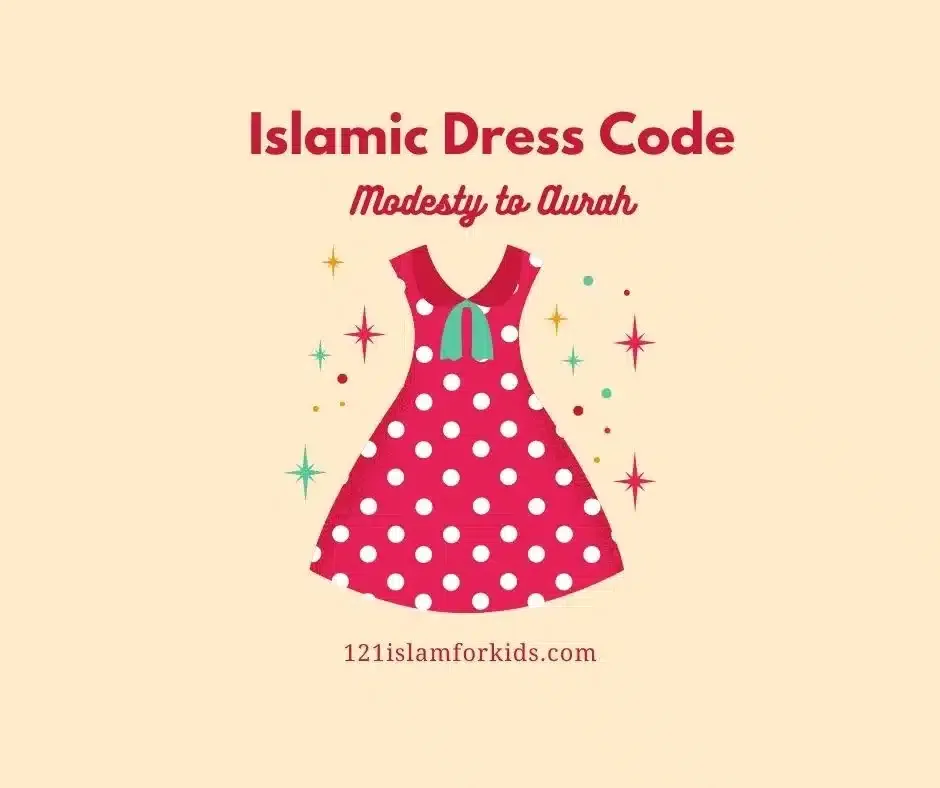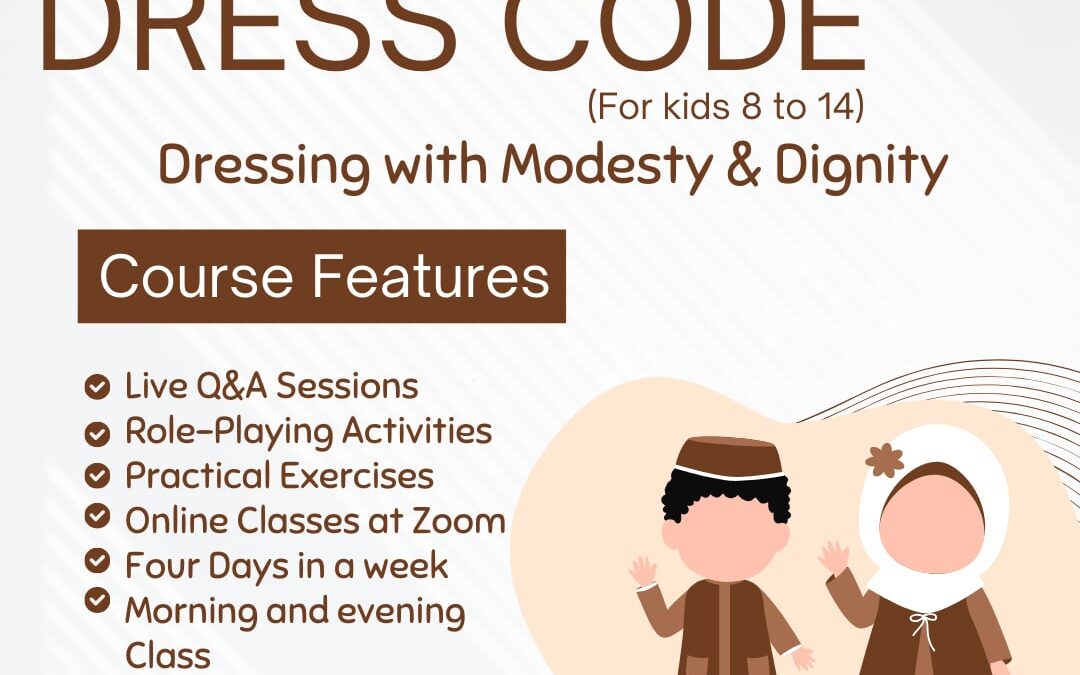Aurah in Islam refers to the parts of the body that should be covered in modesty. It encompasses both physical and behavioral aspects, emphasizing the importance of maintaining modesty in appearance and conduct. We proudly present a course on the Islamic dress code in Quran.

Table of Contents
Islamic Dress Rules for Men:
- Awrah: The awrahIslamic dress code in Quran for men is generally considered from the navel to the knee. It is recommended for men to cover this area, although it is not mandatory in all circumstances.
- Modesty: Men are encouraged to dress modestly, avoiding tight or revealing clothing. It is preferable to wear loose-fitting garments that do not cling to the body.
- Prohibition of Silk and Gold: Muslim men are advised against wearing silk and gold. These materials are considered more appropriate for women to wear.
Islamic Dress Rules for Women:
- Hijab: The hijab refers to the modest dress code for Muslim women. It typically includes covering the body and hair, with the exception of the face and hands. The style of hijab may vary among different cultures and regions.
- Modesty in Clothing: Women are encouraged to wear loose and non-transparent clothing that conceals the shape of their bodies. The clothing should not attract unnecessary attention.
- Awrah: The awrah for women is generally considered the entire body, except for the (face in some cases) and hands. It is recommended that women cover their bodies with loose-fitting clothing.
- Jilbab or Abaya: The jilbab or abaya is a loose, flowing outer garment that covers the body. Muslim women commonly wear it to ensure modesty and fulfill the Islamic dress requirements.
- Prohibition of Makeup and Adornment in Public: Muslim women are advised not to excessively adorn themselves or wear makeup when in public, to avoid attracting unnecessary attention.
It is important to note that interpretations of Islamic dress rules may vary among different scholars and cultures. While these guidelines provide a general understanding, individuals may consult their local scholars for specific rulings or variations based on their circumstances and cultural practices.
The ultimate purpose of Islamic dress rules is to promote modesty, decency, and the preservation of dignity for both men and women. It is an expression of faith and a means of upholding Islamic values in personal appearance and conduct.
Quranic verses and hadiths
Certainly! Here are some Quranic verses and hadiths that discuss the concept of Islamic dress and the covering of the body:
Quranic Verses:
- Surah An-Nur (24:31): “And tell the believing women to reduce [some] of their vision and guard their private parts and not expose their adornment except that which [necessarily] appears thereof and to wrap [a portion of] their headcovers over their chests and not expose their adornment except to their husbands…”
- Surah Al-A’raf (7:26): “O children of Adam, We have bestowed upon you clothing to conceal your private parts and as adornment. But the clothing of righteousness – that is best…”
Hadiths:
- Hadith from Sahih Bukhari: Aisha (may Allah be pleased with her) narrated that Asma, the daughter of Abu Bakr (may Allah be pleased with him), came to the Prophet (peace be upon him) wearing thin clothing. The Prophet (peace be upon him) said to her, “O Asma, when a girl reaches the menstrual age, it is not proper that anything should remain exposed except this and this” – and he pointed to the face and hands.
- Hadith from Sahih Muslim: Ibn Abbas (may Allah be pleased with him) narrated that the Prophet (peace be upon him) said, “Allah does not accept the prayer of a woman who has reached puberty unless she wears a veil.”
These verses and hadiths emphasize the importance of modesty and covering the body, particularly for women. They highlight the obligation to guard one’s private parts, dress in a manner that is not revealing, and use clothing as a means of righteousness and adornment. The specific details of Islamic dress may vary based on cultural customs and interpretations. Still, the underlying principle remains consistent – to dress in a manner that preserves modesty, dignity, and obedience to the commandments of Allah and the teachings of the Prophet Muhammad (peace be upon him).
Teaching Methods Islamic dress code in Islam Modesty, and Covering the Body:
Introduction to Modesty and Islamic Dress:
Provide an overview of the importance of modesty in Islam and the significance of dressing in accordance with Islamic guidelines.
Share Quranic verses and hadiths that emphasize the concept of modesty and the importance of covering the body.
Understanding the Concept of Aurah:
Explain the concept of aurah and its significance in Islamic teachings.
Use visual aids, such as diagrams or illustrations, to depict the body areas that should be covered according to Islamic dress guidelines.
Engage in class discussions to clarify any questions or misconceptions about aurah.
Quranic Verses and Hadiths on Dressing Modestly:
Provide a list of Quranic verses and hadiths that explicitly mention the importance of dressing modestly and covering the body.
Discuss the context and implications of these verses and hadiths to deepen the student’s understanding.
Exploring Different Styles of Islamic Dress:
Introduce various styles of Islamic dress, such as hijab, abaya, niqab, and modest clothing from different cultures.
Show visual examples of these styles and discuss their significance and variations across different regions.
Practical Tips for Dressing Modestly:
Offer helpful guidance on how to incorporate modesty in everyday attire.
Provide suggestions for finding modest clothing that is fashionable, comfortable, and aligns with Islamic guidelines.
Share tips on combining different clothing items to achieve modesty while maintaining personal style.
The Importance of Intention:
Emphasize the significance of intention in dressing modestly and adhering to Islamic guidelines.
Encourage students to reflect on their intentions and develop a sincere desire to please Allah in their choice of clothing.
Addressing Challenges and Misconceptions:
Discuss common challenges and misconceptions related to Islamic dress, such as societal pressures, cultural influences, and stereotypes.
Provide practical advice on how to overcome these challenges and navigate through them while maintaining one’s commitment to Islamic values.
Promoting Positive Body Image and Self-Esteem:
Highlight the positive aspects of modesty, such as promoting self-respect, dignity, and a healthy body image.
Conduct activities and discussions that encourage students to appreciate their bodies as a gift from Allah and embrace their unique qualities.
Role Models and Inspirational Stories:
Share stories of exemplary Muslim individuals who embody modesty and adhere to Islamic dress guidelines.
Discuss the impact of these role models on society and the importance of following their examples.
Practical Application:
Assign practical tasks, such as creating modest outfit ensembles, designing modest clothing sketches, or conducting a research project on modest fashion trends.
Encourage students to reflect on their personal journey towards modesty and share their experiences with the class.
Q&A Sessions and Discussions:
Allocate time for Q&A sessions to address any specific questions or concerns raised by the students.
Facilitate class discussions to encourage students to share their perspectives, experiences, and challenges related to Islamic dress and modesty.
Conclusion and Recap:
Summarize the key points covered in the course and reinforce the importance of adhering to Islamic dress guidelines.
Provide additional resources, such as recommended readings or online platforms, for further exploration of the topic.
By incorporating these teaching methods, students will develop a comprehensive understanding of Islamic dress, modesty, and the significance of covering the body. These methods will not only provide knowledge but also foster a sense of appreciation for the values and principles underlying Islamic dress.
Resources and Activities:
Course Sign up
Other Courses
Leave your thoughts about this course in the comment box


